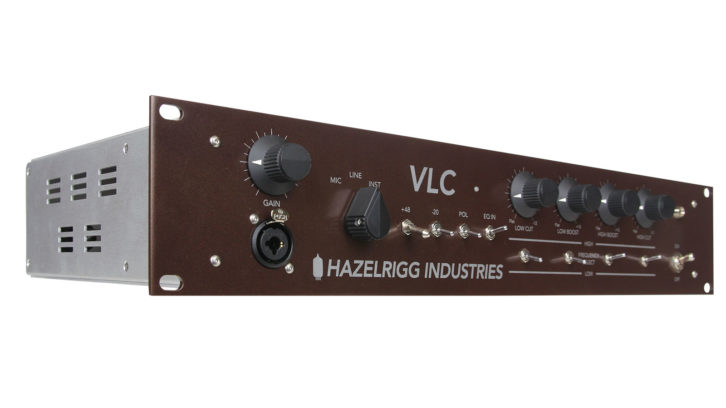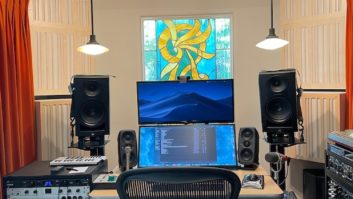
The name Hazelrigg industries was new to me. The fact that it is intrinsically linked to D. W. Fearn sent up a ping of joy, though. I’ve used D.W. Fearn preamps in various studios over the years and have always checked out Doug’s gear at trade shows. For me, he’s one of those larger-than-life audio gurus. He’s the D.W., ferchrissakes!
Brothers Geoff and George Hazelrigg, I would find out, had released an earlier incarnation of the VLC, licensing D.W. Fearn’s circuit designs in order to build the unit they had in mind. Then, after working with Doug in the studio and the lab, the Hazelriggs came to an exclusive licensing agreement to manufacture the D.W. Fearn range of products in 2017, with its roots in the D.W. Fearn circuit design intact, just poured into a smaller, more travel-friendly unit for use in the studio or on the road.
VDI TUBE D.I.
I was introduced to the Hazelrigg products by my audio pals Eric Larsen and Daniel Liston-Keller. They primed me with a tube D.I, the VDI. When the unit arrived, I have to admit that I was a little jaded—in that, “Oh, man, here’s another D.I. How can it be better than the last one?” way.
Well, I always like to be proven wrong when it comes to audio equipment. Lockdown was well under way. Studio work had dried up, live work was nonexistent and here comes this D.I. box. “What can I use it on?” I thought. “There are no recording sessions.” Luckily, my friends from Lasso The Moon open mic in London had decided to produce several Isolation Session videos. These required the occasional addition of guitars, so it was a perfect situation to try out the VDI.
Whether it was a Strat, an SG, my acoustic, a bass or a synth, something magical happened to the signal. I mean, it’s a D.I., it should just be signal in to signal out, but there’s a warmth, a solid bottom end, and what feels like a touch of “compression,” going on that is simply lush and pleasant to the ear.
This hand-built D.I. has headroom to boot. It was designed to go hand in hand with 150″ mic inputs, with the output handled by a custom-designed Jensen transformer. Everything thrown at this unit came out great and slotted right in the mix. It became the main front end for my side of the Isolation Sessions.
In the meantime, the guys set up a Zoom call to talk about the products and how to move forward. I assumed it was just our little trio chewing the fat, so I nearly fell off my chair when both the Hazelrigg brothers AND Doug Fearn showed up on the call!
The thing I miss the most in these difficult times is the face-to-face contact with manufacturers and designers. It wasn’t so long ago that distributors popped around studios to demo their products and have a chat over a cup of coffee. Getting to talk to the people behind the hardware often sparks a flame. This time it was virtual, but I’m glad we got to chat. I was soon introduced to the VLC.
VLC MIC PREAMP
The VLC is a 19-inch, two-rackspace powerhouse. It is a mic/ instrument pre with a Pultec-style EQ strapped to the back of it. And…wait for it. This box takes line level, too!
The VLC arrived just in time. Studios were opening up (with rigorous safety measures in place), and I was asked to engineer the rerecording of “(What’s So Funny ‘Bout) Peace Love and Understanding” for a charity benefit. The lineup was going to include Rat Scabies (Damned) on kit, Horace Panther (The Specials) on bass, Terry Edwards (The Blockheads, Nick Cave) on saxes, Kevin Eldon on vocals, Micko Westmoreland (The Mellotronics) on acoustics, and Jon Klein (Specimen, Siouxsie & The Banshees, Sinead O’Connor) on guitar. Oh, and Nick Lowe himself would be sitting next to me in the producer’s chair!
We decamped to one of my all-time favorite spots, British Grove Studios, to cut the track live. Because the VDI had performed so well, I wanted to know how the VLC would handle bass. Public transport is still a no-no due to the pandemic, and Horace and I decided it would be silly to try and slog a massive bass rig to the studio. I told him I was certain that I had the right setup for him—his P-bass went through the VDI straight into the VLC and then to the DAW.
The result was amazing! My jaw dropped, my assistant’s ears perked up and everybody loved the bass sound; it’s on the record exactly as it was recorded on that day.
I love “old school” units. The nononsense ergonomics just appeal to me. The VLC has that. You select your input on the front panel with the Mic/Line/Inst switch, set your gain and then dial in your desired EQ with the Low cut/boost, High boost/cut and frequency selectors—and you’re up and running.
There’s a -20dB pad, polarity switch, EQ bypass and a locking +48V phantom power toggle. Usually, in all the technical notes, you find the frequencies where the boost and cut happen, I didn’t even ask for the information! Whatever is happening in there is so musical. I strongly believe that in a world where we’re constantly looking at screens and meters, being forced to use your ears is a fine thing indeed.
We now have a superb D.I., a stunning Mic/ Line/Inst preamp and EQ, so what more do you want? How about a “blow your mind” compressor?
VNE COMPRESSOR
The Hazelrigg VNE is a single-channel, five-knob compressor that is quite simply the most versatile analog dynamics processor I have had my hands on to date.
The unit features Doug Fearn’s Class-A vacuum tube design, combined with a Pulse Width Modulation control circuit to drive the compression. In the Hazelrigg tradition, it’s a straightforward, no-frills box: Threshold, Attack, Release, Make Up Gain and a switch that allows you to bypass the unit and also engage the HPF side-chain, which is centred around about a 100 Hz to stop those lovely fat sounds messing with your compression.
I confess, I am a tiny bit allergic to compression, and certainly to over-compression. Most of the time I will track completely clean, with no EQ, no compression—all that happens at the mix stage. Rarely do you come across a compressor that doesn’t add that squashy “claustrophobic” thing. The VNE is one of those rare gems.
When I plugged the VNE in, I was in the middle of a Dub mix for Matt Hoy’s Wonderland. There’s tape delay flying all over the place, and, of course, one of the main features of Dub is the bass-and-drums “riddim.” I decided to pop the VNE on the kick drum and refused to look at the gain reduction meter. In fact, I put some black tape over it to mask it completely. My compression preconceptions were not going to get in the way here.
Right out of the gate, the VNE added a nice warmth and thickness, without any gain reduction going on. After a bit of tweaking and playing around, I got a nice, fat, pumping kick. When I removed the blanking tape, I was stunned at the amount of compression I had dialed in. It did not sound squeezed at all. It simply sounded massive.
It was time to put the VLC and the VNE in series. I fed the kicks and the bass, separately, into the Hazelrigg Golden channel. Out of Pro Tools into the Line input of the VLC and then into the VNE. What came out was just huge! The artist responded with: “I am speechless; you just blew the sides off Wembley!”
When you put the VNE and the VLC together, magic happens. And do not be scared to hammer the input, these boxes can handle it. This chain has now traveled with me to all kinds of sessions—tracking guitars, strings, drums—and if you’re looking for a phenomenal vocal chain, you have found it.
ALL TOGETHER NOW
verything about the Hazelrigg range is pure class. The genius of Doug Fearn circuitry has been poured into understated, bronze powder-coated hardware, with workhorse 12AY7/ 6072 tubes, all combined with a refreshing absence of control labeling It pushes us engineers and musicians to do what the do best: Use our ears!
I will leave you with a little trivia. The Hazelrigg brothers are both pilots, so it made sense to name the compressor VNE: Velocity Never Exceed. With these units, the sky is the limit.







